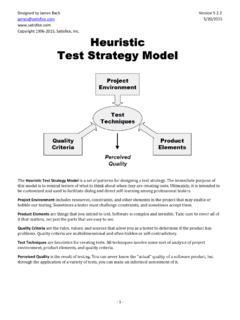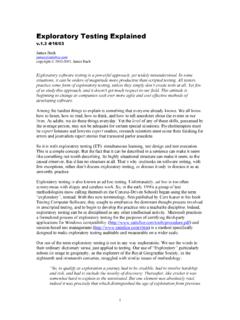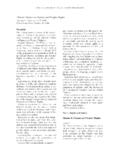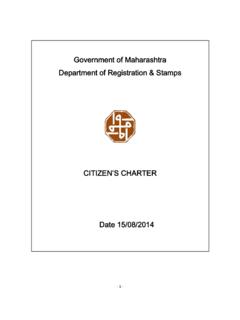Transcription of Session-Based Test Management
1 1 Session-Based Test Managementby Jonathan Bach, published inSoftware Testing and Quality Engineeringmagazine, 11/00)I specialize in exploratory testing. As I write this I am, with my brother, James, leading anexploratory test team for a demanding client. Our mission is to test whatever is needed, on shortnotice, without the benefit, or burden, of pre-defined test procedures. There are other test teamsworking on various parts of the product. Our particular team was commissioned because theproduct is so large and complex, and the stakes are so high. We provide extra testing support tofollow up on rumors, reproduce difficult problems, or cover areas that lie between theresponsibilities of the other traditional scripted testing, exploratory testing is an ad hoc process. Everything we do isoptimized to find bugs fast, so we continually adjust our plans to re-focus on the most promisingrisk areas; we follow hunches; we minimize the time spent on documentation.
2 That leaves uswith some problems. For one thing, keeping track of each tester s progress can be like herdingsnakes into a burlap bag. Every day I need to know what we tested, what we found, and what ourpriorities are for further testing. To get that information, I need each tester on the team to be adisciplined, efficient communicator. Then, I need some way to summarize that information tomanagement and other internal way to collect status is to have frequent meetings. I could say: Ok folks, what did you dotoday? Some testers would give me detailed notes, some would retell exciting stories about coolbugs, some would reply with the equivalent of I tested stuff and fall silent without morespecific prompting. And I d be like the detective at the crime scene trying to make sense ofeveryone s this project, James and I wanted to do better than that.
3 What if we could find a way for thetesters to make orderly reports and organize their workwithoutobstructing the flexibility andserendipity that makes exploratory testing useful? That was our motivation for developing thetool-supported approach we callsession- based test in SessionsThe first thing we realized in our effort to reinvent exploratory test Management was that testersdo a lot of things during the day that aren t testing. If we wanted to track testing, we needed away to distinguish testing from everything else. Thus, sessions were our practice of exploratory testing, a session, not a test case or bug report, is the basic testingwork unit . What we call a session is an uninterrupted block of reviewable, chartered test chartered, we mean that each session is associated with a mission what we are testing or2what problems we are looking for.
4 By uninterrupted, we mean no significant interruptions, noemail, meetings, chatting or telephone calls. By reviewable, we mean a report, called a sessionsheet, is produced that can be examined by a third-party, such as the test manager, that providesinformation about what my team, sessions last 90 minutes, give or take. We don t time them very strictly, because wedon t want to be more obsessed with time than with good testing. If a session lasts closer to 45minutes, we call it ashortsession. If it lasts closer to two hours, we call it of meetings, email, and other important non-testing activities, we expect each tester tocomplete no more than three sessions on a typical specifically happens in each session depends on the tester and the charter of that example, the tester may be directed to analyze a function, or to look for a particular problem,or to verify a set of bug session is debriefed.
5 For new testers, the debriefing occurs as soon as possible after thesession. As testers gain experience and credibility in the process, these meetings take less time,and we might cover several sessions at once. As test lead, my primary objective in the debriefingis to understand and accept the session report. Another objective is to provide feedback andcoaching to the tester. We find that the brief, focused nature of sessions makes the debriefingprocess more tractable than before we used sessions , when we were trying to cover several daysof work at developing a visceral understanding through the debriefings of how much can be done in atest session, and by tracking how many sessions are actually done over a period of time, we gainthe ability to estimate the amount of work involved in a test cycle and predict how long testingwill takeeven though we have not planned the work in there s a magic ingredient in our approach to Session-Based test Management , it s the sessionsheet format: each report is provided in a tagged text format and stored in a repository with allthe other reports.
6 We then scan them with a tool we wrote that breaks them down into their basicelements, normalizes them, and summarizes them into tables and metrics. Using those metrics,we can track the progress of testing closely, and make instant reports to Management , withouthaving to call a team meeting. In fact, by putting these session sheets, tables and metrics online,our clients in the project have instant access to the information they crave. For instance, the chartin figure 1 shows that the testers are spending only about a third of their time actually corresponds to two sessions per day, on average, rather than three sessions . Since the chartrepresents two months of work, it suggests that there is some sort of ongoing obstacle that ispreventing the testers from working at full capacity. Figure 2 allows us to get a rough sense ofhow many more sessions we can expect to do during the remainder of the project.
7 The mostrecent week of data suggests that the rate of testing is of a Test SessionFrom a distance, exploratory testing can look like one big amorphous task. But it s actually anaggregate of sub-tasks that appear and disappear like bubbles in a Jacuzzi. We d like to knowwhat tasks happen during a test session, but we don t want the reporting to be too much of aburden. Collecting dataabouttesting takes energy away compromise is to ask testers to report tasks very generally. We separate test sessions intothree kinds of tasks:test design and execution,bug investigation and reporting,andsessionsetup. We call these the TBS metrics. We then ask the testers to estimate the relativeproportion of time they spent on each kind of task. Test design and execution means scanning theproduct and looking for problems. Bug investigation and reporting is what happens once thetester stumbles into behavior that looks like it might be a problem.
8 Session setup is anything elsetesters do that makes the first two tasks possible, including tasks such as configuring equipment,locating materials, reading manuals, or writing a session TestingWork BreakdownSetup6%Opportunity1%Bug4%Test28 %Non-Session61%Exploratory TestingTest Sessions0501001502002503005/266/96/237/7 7/218/48/184We also ask testers to report the portion of their time they spend on charter versus onopportunity . Opportunity testing is any testing that doesn t fit the charter of the session. Sincewe re in doingexploratorytesting, we remind and encourage testers that it s okay to divert fromtheir charter if they stumble into an off- charter problem that looks from the task breakdown metrics, there are three other major parts of the session sheet:bugs, issues, and notes. Bugs are concerns about the quality of the product. Issues are questionsor problems that relate to the test process or the project at large.
9 Notes are a free-form record ofanything else. Notes may consist of test case ideas, function lists, risk lists, or anything elserelated to the testing that occurs the entire session report consists of these sections: Session charter (includes a mission statement, and areas to be tested) Tester name(s) Date and time started Task breakdown (the TBS metrics) Data files Test notes Issues BugsExample Session SheetCHARTER---------------------------- -------------------Analyze MapMaker s View menu functionality and report onareas of potential risk.#AREASOS | Windows 2000 Menu | ViewStrategy | Function TestingStrategy | Functional AnalysisSTART--------------------------- --------------------5/30/00 03:20 pmTESTER-------------------------------- ---------------Jonathan BachTASK BREAKDOWN------------------------------- ----------------5#DURATION short#TEST DESIGN AND EXECUTION65#BUG INVESTIGATION AND REPORTING25#SESSION SETUP20# charter VS.
10 OPPORTUNITY100/0 DATA FILES----------------------------------- ------------#N/ATEST NOTES----------------------------------- ------------I touched each of the menu items, below, but focused mostlyon zooming behavior with various combinations of mapelements : Welcome ScreenNavigatorLocator MapLegendMap ElementsHighway LevelsStreet LevelsAirport DiagramsZoom InZoom OutZoom Level(Levels 1-14)Previous ViewRisks:- Incorrect display of a map Incorrect display due to interrupted CD may be Old version of CD may Some function of the product may not work at a certainzoom #BUG 1321 Zooming in makes you put in the CD 2 when you get to acertain level of granularity (the street names level) --even if CD 2 is already in the drive.#BUG 1331 Zooming in quickly results in street names not beingrendered.#BUG <not_entered>instability with slow CD speed or low video RAM.







